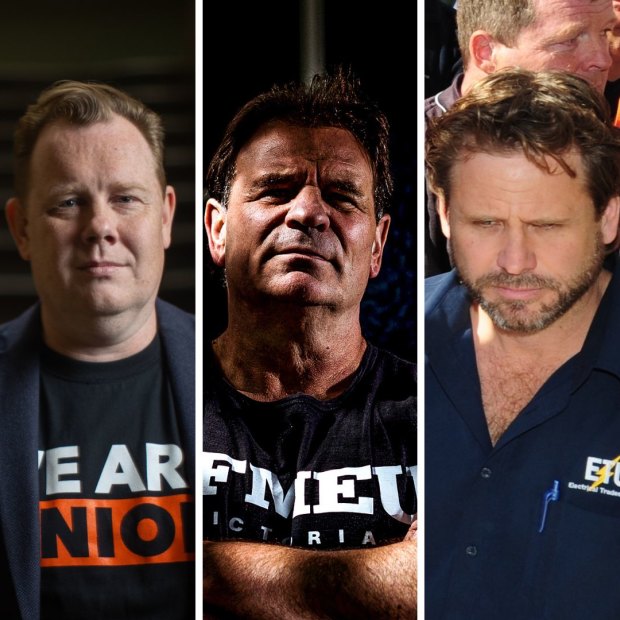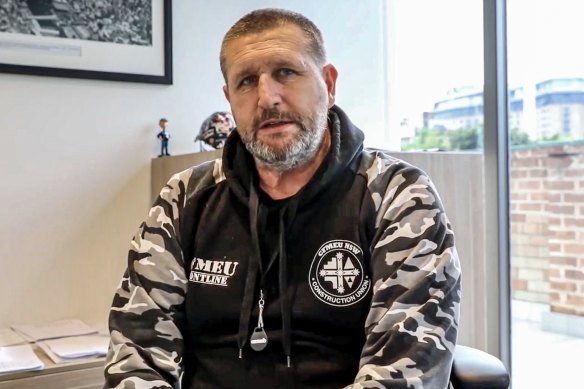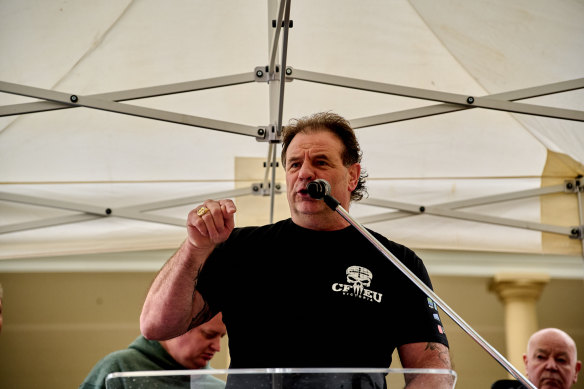This was published 8 months ago
The backers who allowed John Setka’s rise to ultimate power
Five years ago, the head of Australia’s union movement demanded Setka’s resignation. What happened next allowed him to not only survive, but thrive.

Luba Grigorovitch, Luke Hilakari, John Setka, Troy Gray and Christy Cain.Credit: Fairfax Media
Sally McManus could not have been more direct this week as she spoke to the TV cameras and said there was no place for organised crime and corruption in trade unions.
The message was serious, sombre and uncompromising as she was flanked by members of the ACTU executive who minutes earlier had voted to suspend the construction division of the CFMEU from the union peak body.
The dramatic move came amid growing criticism over who knew what and when in the industrial and political wings of the labour movement.
Senior Labor Party figures, from the prime minister down, were scrambling to defend their records in dealing with the construction arm of the CFMEU, in particular with the Victorian division and its recently departed head, John Setka. Victorian Premier Jacinta Allan appeared under particularly intense pressure. McManus herself was subject to a testy interview on ABC’s 7.30.
Yet almost exactly five years ago, McManus stood at the same spot at the ACTU’s headquarters in Melbourne to front the cameras and demand Setka resign after The Age reported extensive details of the domestic violence charges he faced at that time.

ACTU secretary Sally McManus fronts the media in 2019 after her meeting with John Setka.Credit: Jason South
That reporting in June 2019 – based on leaks from the union’s national executive and elsewhere – also included Setka defending his friendship with underworld figure Mick Gatto and his remarks claiming Rosie Batty’s advocacy had diminished men’s rights. The Batty comments became a rolling national drama, overshadowing the serious nature of his conduct.
In 2019, McManus and ACTU president Michele O’Neil had faced intense pressure over what to do. But they stood their ground and made the principled decision that Setka had to go.
There have been no compromises from that position in the five years since, while Setka and the CFMEU’s influence on his national union, the Victorian ALP and big infrastructure projects in his home state have grown ever stronger.

John Setka arriving at the ACTU office to meet Sally McManus in 2019.Credit: Eddie Jim
That moment in 2019 was probably the last and best chance for internal reform of the construction division in Victoria, NSW and nationally, so large has Setka’s influence become.
Much of the union movement supported the ACTU in 2019, with 13 national unions calling for Setka to quit. The ACTU had no formal power to remove him, as unions jealously guard their independence from outside influence.
But the besieged Setka almost certainly would have been forced out if not for the public support garnered from elements of the Victorian Labor Party and industrial left and his own union across Australia. It emboldened and strengthened Setka, who dug in.
These backers have been described by senior union figures as Setka’s “enablers” and deserve significant criticism for the crisis that has risked the future of the CFMEU and by default the wages and conditions of tens of thousands of workers. The damage to the union movement and Labor has been substantial.
These enablers include Victorian Trades Hall Council secretary Luke Hilakari – normally a reliable progressive on social issues – filmed at a private union meeting in 2019 chanting “John Setka here to stay” as he refused to join the calls for Setka to go. This week Hilakari’s proxy at the ACTU executive remained silent as the future of the CFMEU was debated.
Then there was Electrical Trades Union state secretary Troy Gray, who became Setka’s most fanatical and outspoken public supporter. Other key backers include now Victorian state MP Luba Grigorovitch, plumbers’ union head Earl Setches and former senior CFMEU officials Christy Cain and Dave Noonan.
From NSW, Darren Greenfield and Rita Mallia played important roles in backing Setka. And the favour has been returned, with Setka supporting Greenfield to stay in his job despite the serious corruption charges he faces.
Noonan, meanwhile, won Setka’s backing last year to become a director of $90 billion superannuation fund Cbus, where he joined Setka allies Mallia, the union’s NSW president, and Setches.

CFMEU NSW secretary Darren Greenfield, who is facing bribery charges, supported Setka remaining at the CFMEU.
There was also the silence from many who gained factional and financial benefit over the years from Setka’s union in the Labor Party, particularly in Victoria, where its political and industrial strength has grown significantly since 2019, and it has managed to displace the rival Australian Workers Union’ on big infrastructure projects.
It’s not just Labor. The Greens have received donations in the past from the construction division and have been unusually quiet about Setka over the years. In 2019, the party refused to say if it would take further donations from the union, despite Setka’s record of domestic violence.
It is clear that Setka’s instincts to run the union as a despot have intensified. The resignation of his deputy Shaun Reardon – who in 2019 demanded Setka go – left Setka utterly dominant. He’s since been surrounded by yes-men such as his offsider Derek Christopher, who remains the subject of a police corruption probe. An investigation by this masthead this week found he also received an estimated $200,000 in free labour and supplies from major building companies. Other senior officials have proved weak and complicit.

John Setka at a CMFEU trade union rally march from Belmore Park to NSW Parliament House in 2023.Credit: Michael Quelch
The infiltration of organised crime has clearly intensified too. When the union’s own members and construction workers rioted in 2021 and attacked the union’s offices over COVID restrictions, with some condemning Setka as then-premier Daniel Andrews’ “bitch”, some union sources saw it as a turning point.
Setka had been spooked by the revolt of his members, the sources have claimed.
Throughout this period, Setka – with his Trump-esque ability to successfully spin almost any bad behaviour – was becoming more powerful in some forums but also more isolated from the federal ALP.
In Canberra, the union had become almost a pariah with Anthony Albanese as ALP leader (in 2019 Albanese had successfully pushed for Setka to leave the party after his Batty comments).
Part of Setka’s success – and ongoing survival – was being able to gull sections of the tabloid and commercial media who treated the garrulous trade unionist as a bit of fun, never seriously questioning him on his record and links to organised crime figures or the ongoing allegations against him of often vicious domestic violence.
Yet, on Friday, July 12, that whole edifice came crashing down when Setka ended his 12-year reign after being sent questions from the joint investigation by this masthead, The Australian Financial Review and 60 Minutes.
The power vacuum this created appeared to confuse the response from remaining officials and cruel attempts by new national secretary Zach Smith to assume control of Setka’s former branch, which also covers Tasmania and South Australia.
Within days, the government said the response was not good enough (Smith, for instance, would not stand down Greenfield over corruption charges), and it would move to place Setka’s branch into administration along with NSW and Queensland.
Already the pushback has started, with Queensland secretary Michael Ravbar accusing Albanese of having “soiled himself” in response to untested media allegations.
Some union activists, meanwhile, have started arguing the appointment of administrators is barely disguised union-busting with the complicity of Labor and the ACTU, whose 52-member executive endorsed the move.
The appointment of administrators is clearly a loss of member democracy, as occurred at the Health Services Union in 2012. But the record shows that union is now in far better shape than the corruption-riddled mess it was.
And in Victoria, in particular, how democratic was the CFMEU’s construction division anyway? If you were a worker on site and your delegate had come straight from a senior position at a bikie gang and had been appointed by union head office without your input, how democratic is that? And how confident would you feel to raise a workplace issue?
Setka, meanwhile, had filled the union’s committee of management with friends and supporters. The Age has long been aware of CFMEU activists too scared or “encouraged” not to run a ticket against Setka and allies at union elections. If this was a democracy, it was one in name only and hardly a model of genuine member control.
On Wednesday, McManus, as she had five years earlier, had to publicly address the serious problems caused by Setka and the CFMEU and also announce the ACTU executive had endorsed the government’s position that the union be put into external administration.
Her role was crucial. Without the support of the ACTU and other senior union leaders, it is hard to imagine a Labor government being able to act as boldly as it did.
But it would not have come to this if more Labor and union people had endorsed the principled position in 2019 that Setka should go.
In the end, the person most to blame for what has happened at the CFMEU is Setka, a man whose 30-year career at the union has left it in ruins.
He is a man consumed by a thirst for revenge and control who had come to completely dominate his branch. His malign influence has been felt across the union nationally.
He would never have lasted this long without so many enablers.